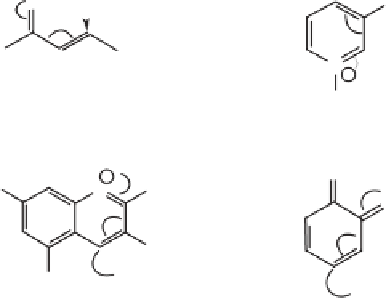Biomedical Engineering Reference
In-Depth Information
2-
SO
2-
3
SO
3
C
O
P
S
S
P´
I
II
2-
SO
3
2-
O
SO
CONH
3
2
N
+
R
III
IV
O
+
HO
Ph
O
O
OG
2-
SO
HO
3
2-
SO
3
VI
V
FIGURE 8.6
Examples of nucleophilic reactions of sulfite ion with food components. (I)
Attack at a carbonyl group as the first step in the formation of hydroxysulfonates. (II) Cleavage
of a disulfide bond. (III) Addition to α,β-unsaturated carbonyl compounds. (IV) Addition of
sulfite ion to the nicotinamide moiety of NAD
+
. (V) Addition to the benzopyrrylium structure
of anthocyanins and responsible for the bleaching of the red colors of many fruits.
(VI) Addition to
o
-benzoquinone as an example of the first step in the inhibition of enzymic
browning by converting
o
-quinones to the corresponding sulfodiphenols.
conversion of SO
3
2-
to HSO
3
-
in the presence of certain non-electrolytes, all lead to
a reduction in the nucleophilic reactivity of S(IV).
A selection of nucleophilic reactions of SO
3
2-
, of direct relevance to food quality,
important functions of S(IV) in food, that of an antimicrobial agent and as an
inhibitor of nonenzymic browning.
Chemistry of the Antimicrobial Behavior of S(IV)
It has long been recognized that undissociated SO
2
·H
2
O is the effective antimicrobial
species in S(IV) mixtures, and the general use of the term “molecular SO
2
” in this
context is remarkably well informed, at a time when few are still aware of the
unlikely existence of sulfurous acid as H
2
SO
3
. Definitive experiments carried out by
Rose and his group demonstrated that uptake of SO
2
by yeast cells involves passive
transport (diffusion) of SO
2
across cell membranes.
26-28
The initial rate of accumu-
lation of S(IV) in cells is related logarithmically to the pH of the suspension medium
(range pH 3 to 5) confirming SO
2
as the important species. Woolf-Hofstee plots are

























Search WWH ::

Custom Search